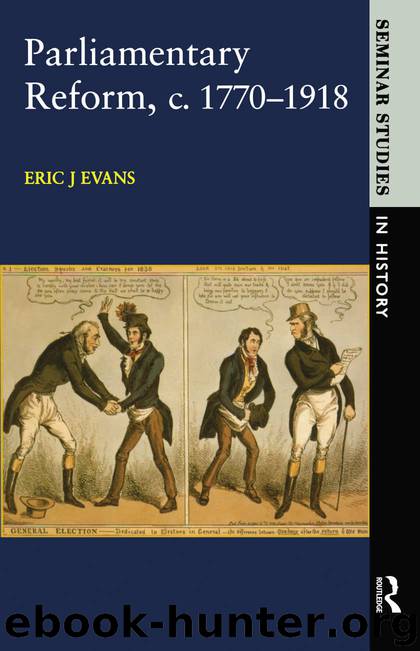Parliamentary Reform in Britain, c. 1770-1918 (Seminar Studies) by Eric J. Evans

Author:Eric J. Evans [Evans, Eric J.]
Language: eng
Format: azw3
ISBN: 9781317886235
Publisher: Taylor and Francis
Published: 2014-07-22T04:00:00+00:00
WOMEN AND LOCAL POLITICS
Many sceptics about women’s suffrage in the 1880s also pointed out that women already had the franchise in many areas of public life which, if not exactly personal, might be considered literally closer to the world of home and hearth. Women ratepayers could vote for poor law guardians under the terms of the Poor Law Amendment Act of 1834. The Municipal Franchise Act of 1869 permitted women ratepayers to vote on the same terms as men, though this was restricted to unmarried women three years later [98 p. 7] (see Chronology). They could not only vote for school boards after their creation under the Education Act of 1870 but could also be elected to those boards. The County Councils Act of 1888, which followed the third Reform Act, also gave women householders the vote. The Parish and Rural District Councils Act of 1894 permitted them both to vote and to stand as candidates. By 1900, about one million unmarried ratepaying women qualified for the vote in local elections. By no means all were middle class, as was the widespread assumption both at the time and among historians until recently [98 p. 32]. John Burns, an ex-engineer, trade unionist and Labour politician in London who later joined the Liberal party, passed legislation in 1907 permitting women to stand as candidates in both borough and county council elections.
Male supporters of a woman’s franchise, such as William Woodall, Burns and David Lloyd George, noted that women had exercised the local vote sensibly. Their record as local representatives on district councils, school boards and the like had generally been exemplary. As Burns pointed out in 1907, ‘In regard to disorderly houses, and in many questions of public health administration, women were better suited than men, in many cases they were the only persons qualified to carry out the work’ [98 p. 46]. Opponents turned these arguments around by suggesting that such service only confirmed that separate spheres did exist and that women were best kept away from central politics. Supporters responded by pointing out how much legislation in Edwardian England was concerned with home and family. As Ethel Snowden, the suffrage campaigner who was also the wife of the Labour pacifist politician Philip Snowden, put it in her book, The Feminist Movement (1913): ‘because the special sphere of woman is the home, women ought to have the vote’ [18 p. 208].
The dominant suffragist argument was that women deserved the vote on the same terms as men. The changes of 1867–68 and 1884 produced, in effect, a household suffrage (see p. 73). Such a qualification would result in a franchise skewed towards spinsters and widows. This grated with many MPs. They had assimilated the ‘separate spheres’ argument and argued that women were not ‘proper’ examples of their sex unless they had fulfilled their manifest destiny to marry. Also, why should the house-owning brothel madam have the vote when the respectable wife was denied it [17]? Such reasoning ignored the uncomfortable fact of demographic change.
Download
This site does not store any files on its server. We only index and link to content provided by other sites. Please contact the content providers to delete copyright contents if any and email us, we'll remove relevant links or contents immediately.
The Vikings: Conquering England, France, and Ireland by Wernick Robert(79852)
Ali Pasha, Lion of Ioannina by Eugenia Russell & Eugenia Russell(40117)
The Conquerors (The Winning of America Series Book 3) by Eckert Allan W(37098)
The Vikings: Discoverers of a New World by Wernick Robert(36905)
Cecilia; Or, Memoirs of an Heiress — Volume 1 by Fanny Burney(32403)
Cecilia; Or, Memoirs of an Heiress — Volume 3 by Fanny Burney(31802)
Cecilia; Or, Memoirs of an Heiress — Volume 2 by Fanny Burney(31773)
Empire of the Sikhs by Patwant Singh(22944)
The Secret History by Donna Tartt(18797)
Hans Sturm: A Soldier's Odyssey on the Eastern Front by Gordon Williamson(18451)
Cat's cradle by Kurt Vonnegut(15138)
Pimp by Iceberg Slim(14290)
Sapiens: A Brief History of Humankind by Yuval Noah Harari(14198)
Talking to Strangers by Malcolm Gladwell(13172)
Norse Mythology by Gaiman Neil(13160)
Leonardo da Vinci by Walter Isaacson(13134)
4 3 2 1: A Novel by Paul Auster(12253)
Underground: A Human History of the Worlds Beneath Our Feet by Will Hunt(11993)
The Radium Girls by Kate Moore(11891)
